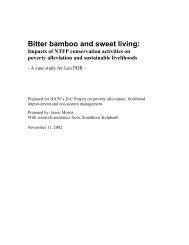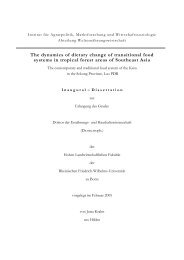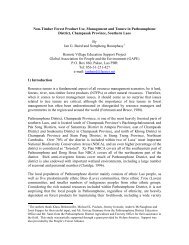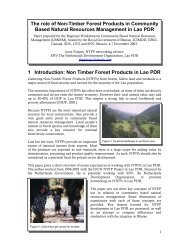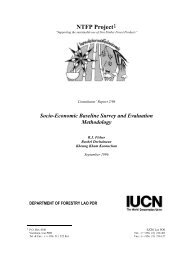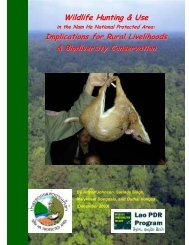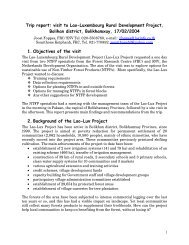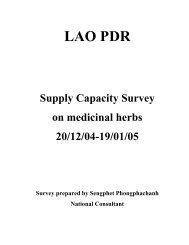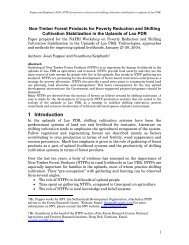You also want an ePaper? Increase the reach of your titles
YUMPU automatically turns print PDFs into web optimized ePapers that Google loves.
not <strong>on</strong>ly used for home c<strong>on</strong>sumpti<strong>on</strong> but are becoming an important trade product. The<br />
reducti<strong>on</strong> of b<strong>on</strong>g bark is probably due to depleti<strong>on</strong> of the stock. Rattan canes have all but<br />
disappeared, cardamom remains stable. This picture may still change as we are early in the<br />
year.<br />
7.2 How (un-)sustainable is the present use system?<br />
The harvesting of all wildlife, rattan canes (Calamus sp.), eaglewood (Aquilaria crassna) and<br />
‘hak tin houng’ (Helminthostachys zeylanica) are particularly destructive and should be<br />
terminated. Harvesting of kisi resin is mainly threatened by logging of the commercially<br />
interesting wood of Parashorea spp. This logging should be limited. Harvesting of b<strong>on</strong>g bark<br />
(Notaphoebe umbelliflora) has been very intensive lately and harvestable trees have almost<br />
disappeared from the forest. However this tree can coppice easily from roots and may come<br />
back, even though it takes 3-4 years for stems to regrow.<br />
7.3 How would the planned reservoir affect the availability of NTFP’s?<br />
Overall, 60 % of NTFP’s was classified as collected from streams, p<strong>on</strong>ds, paddy fields, grass<br />
fields and fallow fields, which are not strictly forest areas. These areas are likely to be mostly<br />
situated within the inundati<strong>on</strong> z<strong>on</strong>e. Only 25 % was said to be derived for the evergreen<br />
forest and mountains. Only 16 % of all NTFP’s are said to be derived from the proposed<br />
resettlement area, called “pa kok” by villagers. It is also remarkable that little difference in<br />
opini<strong>on</strong> was found between groups of men and women <strong>on</strong> this issue.<br />
We found that villagers are able to identify forest blocks and main products collected per<br />
block. Villagers estimates of yield potential for all blocks were too variable to be useful.<br />
However the delineati<strong>on</strong> of forest use blocks seems to have a great potential for future<br />
participatory forest management.<br />
7.4 What are the possibilities for exploiting NTFP’s in the proposed<br />
settlement area?<br />
The present lifestyle of most villagers <strong>on</strong> the <strong>Nakai</strong> plateau is not very sustainable. Families<br />
have to face c<strong>on</strong>stant rice shortages and irregular floods. Forest products are the main source<br />
of cash income but cannot supply enough cash to buy rice to feed the family all year round.<br />
Due to high collecting pressure and increased logging, the availability of most NTFP’s is<br />
getting smaller. In the case of an inundati<strong>on</strong> of the proposed reservoir, the availability of<br />
NTFP’s will be reduced even more.<br />
Because of its poor soils, the proposed resettlement area <strong>on</strong> the southern edge of the<br />
escarpment can <strong>on</strong>ly produce very few NTFP’s and the potential for cultivating NTFP’s as<br />
crops seems to be limited. Within these limits, some products may have a potential for<br />
domesticati<strong>on</strong> which could be developed.<br />
Our work has also shown the effectiveness of RRA tools in analysing the village ec<strong>on</strong>omy, in<br />
particular in identifying poor and wealthy families. These techniques could also be used by



